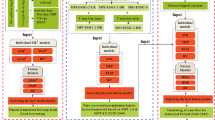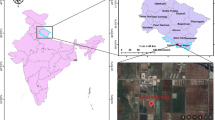Abstract
The classical methods for interpolating and spatial averaging of precipitation fields fail to quantify the accuracy of the estimate. On the other hand, kriging is an interpolation method for predicting values of regionalized variables at points (punctual kriging) or average values over an area (block kriging).
This paper demonstrates the use of the kriging method for mapping and evaluating precipitation data for the State of Arizona. Using 158 rain gauge stations with 30 years or more of record, the precipitation over the state has been modeled as a realization of a two dimensional random field taking into consideration the spatial variability conditions.
Three data sets have been used: (1) the mean annual precipitation over the state; (2) the mean summer rainy season; and (3) the mean winter rainy season. Validation of the empirical semi-variogram for a constant drift case indicated that the exponential model was appropriate for all the data sets. In addition to a global kriging analysis, the data have been examined under an anisotropic assumption which reflects the topographic structure of the state.
Similar content being viewed by others
References
Bastin, G.; Lorent, B.; Duque, C.; Gevers, M.: Optimal estimation of the average areal rainfall and optimal selection of rainfall gauge location. Water Resources Research 20, 4, 463–470 (1984)
Chua, S. C.; Bras, R. L.: Optimal estimator of mean areal precipitation in regions of orographic influence. Journal of Hydrology 57, 23–48 (1982)
Creutin, J. D.; Obley, Ch.: Objective analysis and mapping techniques for rainfall fields: An objective comparison. Water Resources Research 18, 2, 413–431 (1982)
Delfine, P..; Dellhomme, J. P..: Optimum interpolation by kriging. In: Davis, J. C..; McGullagh, M. J.: (ed.), display and Analysis of Spatial data. John Wiley, New York 1975.
Delhomme, J. P.: Kriging in the hydroscience. Advances in Water Resources 1, 5, 251–266 (1978)
De Montmollin, F. A.; Olivier, R. J.; Simard, R. G.; Zwahlen, F.: Evaluation of a precipitation map using a smoothed elevation-precipitation relationship and optimal estimates (kriging). Nordic Hydrology 11, 113–120 (1980)
Hall, A. J.; Barclay, P. A.: Methods of determining areal rainfall from observed data. In: Chapman, X.; Dunin, X (eds.), Prediction in Catchment Hydrology, Griffin, Australia 1975.
Hendricks, D. M.: Arizona Soils. University of Arizona, College of Agriculture, Tucson, Arizona 1985
Karnieli, A.; Osborn, H. B.: Factor affecting seasonal and annual precipitation in Arizona. Proceedings of the 1988 Meeting of the Arizona Section American Water Resources Association and the Arizona-Nevada Academy of Science 18, 7–18, 1988.
Journel, A. G.; Huijbregts, C. J.: Mining Geostatics. Academic Press, New York 1978.
Lenton, R. L.; Rodriguez-Iturbe, I.: Rainfall network systems analyses: the optimal estimation of total areal storm depth. Water Resources Research 13, 5, 825–836 (1977)
Matheron, G.: The theory of regionalized variables and its application. Cha. Cen. Morphol. Math., 5, Ecol Mines, Fontainbleau 1971.
Neuman, S. P.; Jacobson, E. A.: Analysis of nonintrinsic spatial variability by residual kriging with application to regional groundwater levels. Mathematical Geology 16, 5, 499–521 (1984)
Obled, Ch.; Creutin, J. D.: Some developments in the use of empirical orthogonal functions for mapping meteorological fields. Journal of Climate and Applied Meteorology 25, 9, 1189–1204 (1986)
Olea, R. A.: Optimum Mapping Techniques Using Regionalized Variable Theory. Kansas Geological Survey, 1975.
Sellers, W. D.; Hill, R. H.; Sanderson-Rae, M.: Arizona Climate —The First Hundred Years. University of Arizona, Tucson, AZ, 1985.
Author information
Authors and Affiliations
Rights and permissions
About this article
Cite this article
Karnieli, A. Application of kriging technique to areal precipitation mapping in Arizona. GeoJournal 22, 391–398 (1990). https://doi.org/10.1007/BF00174760
Issue Date:
DOI: https://doi.org/10.1007/BF00174760




